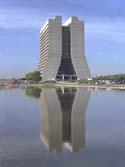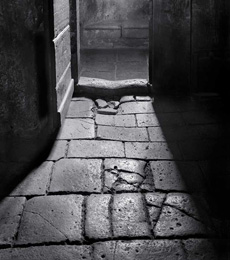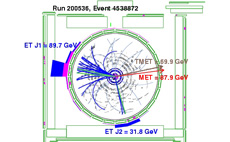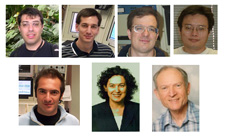|
Thursday, Jan. 31
1 p.m. - 6:30 p.m.
P5 meeting
THERE WILL BE NO PHYSICS AND DETECTOR SEMINAR THIS WEEK
2 p.m.
Computing Division Seminar - FCC1
Speaker: D. Yocum, Fermilab
Title: The FermiGrid High Availability System
2:30 p.m.
Theoretical Physics Seminar - WH-3NW (NOTE LOCATION)
Speaker: J. Bailey, Fermilab
Title: Light-Quark Baryon Spectroscopy with Staggered Fermions
3:30 p.m.
DIRECTOR'S COFFEE BREAK - 2nd Flr X-Over
THERE WILL BE NO ACCELERATOR PHYSICS AND TECHNOLOGY SEMINAR TODAY
Friday, Feb. 1
9 a.m.-3 p.m.
P5 meeting
Noon
Wellness Works Brown Bag Seminar - Curia II
Speaker: S. Brown, MD
Title: Easy Strategies for Weight Loss
2:30 p.m.
Particle Astrophysics Seminar - Curia II (NOTE DATE)
Speaker: K. Van Bibber, Lawrence Livermore National Laboratory
Title: Ultrasensitive Searches for the Axion
3 p.m. - 4:30 p.m.
P5 Town Hall meeting
4:30 p.m.
DIRECTOR'S COFFEE BREAK - 2nd Flr X-Over (NOTE TIME)
5 p.m.
Joint Experimental-Theoretical Physics Seminar - One West (NOTE TIME)
Speaker: E. Lipeles, University of California, San Diego
Title: To be announced
Click here for NALCAL,
a weekly calendar with links to additional information.
|
Thursday, Jan. 31
- Santa Fe black bean
- Sloppy joe
- Chicken cordon bleu
- Steak
- Baked ham & Swiss on a ciabatta roll
- Assorted slice pizza
- Crispy fried chicken ranch salad
Wilson Hall Cafe menu |
|
Thursday, Jan. 31
Dinner
- Closed
Wednesday, Feb. 6
Lunch
- Northern Italian lasagna
- Caesar salad
- Cassata
Chez Leon menu
Call x4598 to make your reservation. |
|
|
P5 to help form Fermilab future
 |
| The new P5 will meet at Fermilab today and Friday to discuss the formation of a new 10-year plan for the laboratory. |
The Particle Physics Project Prioritization Panel will meet at Fermilab this week in the first of three cross-country town hall meetings to aid in forming a new 10-year-plan for U.S. particle physics.
By April, P5 will make a recommendation to the U.S. High Energy Physics Advisory Panel that takes into account the field's fluid nature and considers projects in different budget scenarios.
"What it will mean, in my view, is the roadmap will really be a roadmap, not a road. A roadmap has many turns and branch points," said Mel Schochet, ex-officio as HEPAP chair.
The development of a plan for particle physics, recommended by a new P5 panel, gives the laboratory a chance to make the case for Project X R&D and extension of the Tevatron run and to reiterate support for the neutrino program and LHC commitments.
"One of the things P5 will look at is broadening the scope of accelerator experiments beyond the ILC," said Robert Tschirhart, P5 member.
That likely will include CLIC at CERN and the Muon Collider at Fermilab.
ILC participation remains a priority, but potentially at different funding levels, possibly opening the door to a more diversified research portfolio.
"I would say what we are looking for is to retain our path to the energy frontier but also build breadth to the field through astrophysics and through intensity frontier facilities," Tshirhart said.
P5 will consider U.S. participation in research plans in Europe and Asia and look for opportunities for vital U.S.-based projects.
"Fermilab is our flagship for particle physics," said Charles Baltay, P5 chair. "I'm coming with an open mind and will listen to what everyone has to say."
View the meeting agenda here.
--Tona Kunz
|
Worth 1000 words
Photos capture untold stories

The Fermilab Art Gallery currently features an exhibit of photography, including Jeff Curto's "Santo Stefano di Sessanio, Abruzzo."
The newest art exhibit in the Fermilab Art Gallery features works by photographers who love to get close to their subjects. Work on display through March 14 includes "Evidence of Hands on Stone" by Jeff Curto and "Flowers: Colors, Lines and Shapes" by Tanya Lunina. All employees may attend an opening reception Friday from 5-7 p.m. in the Fermilab Art Gallery.
Lunina's close-up images capture the flowers' lines, shapes and colors, highlighting the intricate and original design of each. "I try to find something unique in every flower," she said.
 |
| Tanya Lunina's "Flowers: Colors, Lines and Shapes" is part of the current exhibit of the Fermilab Art Gallery. |
Lunina began photographing flowers as a hobby a few years ago when she came to the United States from Russia with her husband, Andrei Lunin, an employee in Fermilab's Technical Division. She uses a Canon 30D and prints her images on an ink jet printer.
Curto, a professor of photography at College of DuPage, began photographing Italy's architectural landscapes after a trip to the country in 1989. During each subsequent trip, he searches for inspiration in the subtle layering of ancient and modern materials and elements and care that have helped to shape each architectural landscape he photographs.
"Ultimately, one of the things that I am as a photographer is a storyteller," Curto said.
Curto said the title of his project, "Evidence of Hands on Stone," came from the idea that the buildings have been touched.
"When you walk into the Pantheon, or through a doorway, you think of all the people who have walked through that door for hundreds of years. You really get a sense of people who honored these buildings," Curto said.
Curto takes photographs are taken with a 1982 Deardorff camera. The high-quality 4-inch by 5-inch negatives produced from the camera are then scanned and printed on an ink jet printer.
--Rhianna Wisniewski
|
Gravity: the 'Holy Grail' of physics
From BBC.com,
Jan. 29, 2008
Isaac Newton wrote down his theory of gravity in 1689, and his equations are used to this day to send space probes to the outer edges of our Solar System.
So what could possibly be wrong with our understanding of it?
There are problems with Newton's theory, however. It doesn't quite describe the orbit of Mercury, the closest planet to the Sun, and as Newton knew very well it has nothing to say about what the force of gravity actually is.
It took over 200 years and the genius of Albert Einstein to discover a deeper theory.
Einstein's General Theory of Relativity describes the force we see as gravity as being due to the bending and curving of space and time (or to be more accurate "space-time") by heavy objects like the Earth and Sun.
Read more
|
|
|
Searching for the missing link using missing energy

A CDF event display for the most Higgs-like event of this analysis. Shown are two jets, labelled "J1" and "J2," each with their transverse energies, "ET." Two calculations for the missing energy of the event are also shown. "MET" is the missing transverse energy measured from the calorimeter, and "TMET" is the missing transverse energy calculated from charged tracks.
The Higgs boson holds a special place in the Standard Model because it may be responsible for giving other elementary particles mass. While we've observed the effects of the Higgs, we have yet to physically observe this missing link, making the Higgs boson the most highly sought after particle of the last 30 years, and a main focus of Fermilab's collider physics program.
One way the Higgs boson can be produced is with a Z boson, a force carrier of the weak interaction. The Higgs boson can decay to a pair of b-quarks, which each produce a spray of particles called "jets." The Z boson can decay to neutrinos, which are invisible to collider detectors. These events would then appear very unique since two jets would seemingly recoil against nothing. Physicists use momentum and energy conservation to measure this "nothing," and label it "missing energy."
Using observations of events of two jets with missing energy, CDF physicists have recently searched for Higgs bosons. Since Standard Model background contributions that create missing energy are notoriously difficult to quantify, analysts first established techniques for testing the size and shape of these backgrounds, and searching for the Higgs boson using the mass of the two jets in the event (learn more). Next, CDF physicists devised alternate calculations of the missing energy in the events, and used these in conjunction with artificial neural networks to improve the sensitivity for finding the Higgs boson (learn more).
So far, the Higgs has not been observed. However, the Tevatron's ability to deliver large amounts of data to the CDF and DZero experiments continually improves. Physicists at those experiments also continually improve their analysis techniques, making them ready to observe the Higgs boson when they get their chance.

Left to right. Top: Artur Apresyan, Purdue University; Viktor Veszpremi, Purdue University; Oscar Gonzalez Lopez, CIEMAT, Madrid; and Son Ming Wang, Academia Sinica. Bottom: Fabrizio Margaroli, Purdue University; Daniela Bortoletto, Purdue University; and Art Garfinkel, Purdue University.

Left to right: Brandon Parks, Richard Hughes, Brian Winer and Ben Kilminster, all from Ohio State University.
Result of the Week Archive
|
Antiproton stacking record
On Tuesday morning, Jan. 29, at 10:47 a.m. the Antiproton Source set a new Pbar hourly stacking rate record of 25.19mA/hr. Congratulations to all!
|
|
Have a safe day!
Employee art show this spring
Another inspiring art exhibition by Fermilab employees and immediate family members will take place this spring. "Hidden Talents: Fermilab Employee Art Show" will be on display, March 19 - May 14, 2008. Intent applications are available in the Art Gallery on the cube near Curia II. More information.
Employee Assistance Program
The January newsletters of the Employee Assistance Program are now available for employees and supervisors. The newsletters provide tips for the new year and information on the Employee Assistance Program, which is provided by VMC Behavioral Healthcare Services. Brian Malinowski, EAP counselor, is at Fermilab on Wednesdays and Fridays, x3591, brianm@fnal.gov. As an employee, you have 24-hour access to assistance, seven days a week by calling 1-800-843-1327.
Brown Bag Seminar on weight loss
Sheron Brown, MD, will present a Brown Bag Seminar Friday, Feb. 1, from noon to 1 p.m. in Curia II entitled "Easy Strategies for Weight Loss."
Recreation class registration due Friday
Registration for the Muscle Toning Class must be submitted Friday for
the Feb. 5-28 class. The class costs $36 per person. You must be a current member of the gym to register.
Registration for Yoga must be submitted by Friday for the Feb. 5 to March 25 class. $80 per person.
Blood Drive February 19, 20
Mark your calendars. Heartland Blood Centers will host the
Fermilab Blood Drive on Feb. 19-20, from 8 a.m - 2 p.m. in the
Wilson Hall Ground Floor NE Training Room. Appointments can be scheduled on
the web or by calling Diana, x3771, or Margie, x5680. Although we welcome walk-ins, appointments will be taken first.
Additional Activities |
|





